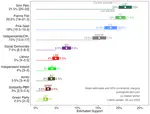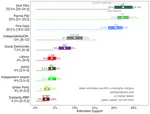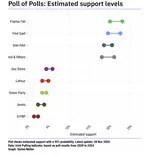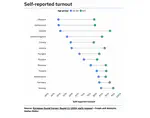Related Projects
Irish Demographic Polling Datasets
In addition to the Irish Polling Indicator data, the Irish Demographic Polling Datasets collect results on vote intentions, satisfaction with the government, and popularity of party leaders. The polling results are available for all respondents and various subsamples, such as age groups, gender, social class, geographic region, and district magnitude. The database merges over 100 polls, published between 2011 and 2025. The datasets can be accessed, visualised, and downloaded through an interactive dashboard.
- Government satisfaction (all respondents and subsamples): csv, Stata (dta), R (rds)
- Satisfaction with party leaders (all respondents and subsamples): csv, Stata (dta), R (rds)
- Vote intentions (all respondents and subsamples):
All datasets and variables are described in a detailed report and codebook (PDF).
If you use the stable version in your work, please consider citing:
Stefan Müller, Thomas Pluck, and Paula Montano. 2025. Irish Demographic Polling Datasets. URL: https://github.com/Irish-Dem-Polling/datasets
Irish Politics Data
The Irish Politics Data project collects links to datasets, text corpora, and dashboards on Irish politics. The website features polling results, national and cross-national surveys, election results, legislative data, party manifestos, parliamentary speeches, policy agendas, annual reports, and relevant literature from both the Republic of Ireland and Northern Ireland. The project aims to guide researchers, policymakers, journalists, and citizens to data and empirical literature on politics on the island of Irelan



